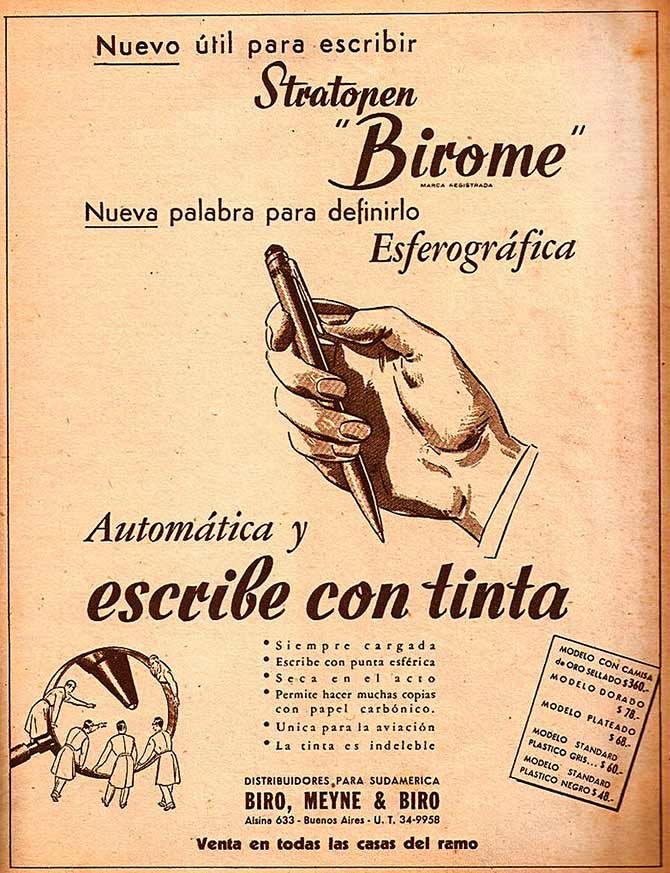 | « Back to article | Print this article |
Tracing the early life of the humble ballpoint pen to its present.

Pen maker John Loud got a ballpoint pen patent in 1888.
Anton Shaeffer in 1901.
Michael Brown in 1911.
While Lorenz presented a prototype ball pen in 1924.

But none of them was successful in bringing the product to the market till László Bíró came along in 1938. Apparently simple innovations seem to take a lot of time from conception to adolescence.
I have been likening innovation to human life: A concept in the brain is like the fertilisation of a foetus in the womb, after which the concept develops as a “life”.
This month, I will trace the early life of the humble ballpoint pen.
The ballpoint pen, which took over half a century from conception to adolescence, secured funding on March 3 80 years ago after a historic meeting in Budapest.

Ballpoint pen? Innovation?
Modern folks would not even think of the ballpoint pen as an innovation. It seems to be an inexpensive writing instrument, not worth too much thought.
Yet it had to fight for a life.
Consider that just 50 years ago, Indian banks would not accept a cheque written with a ballpoint pen -- they had to be written with a fountain pen. Today, the ball pen’s life is threatened by digitisation just as the ball pen itself had threatened the life of its predecessor, the fountain pen.

On March 3, 1938, Andor Goy sat at a café with fellow Hungarian, László Bíró in Budapest. Bíró’s hands were smeared with ink left over from continuous experimentation with his new invention as he “pitched for funding”.
Goy was sceptical because of Bíró’s lack of experience in the pen industry. The truth was that writing instrument innovation was led by “non-pen” people: Lewis Edson Waterman was a salesman, who suffered his inefficient fountain pen; so also George Safford Parker, a telegraphy instructor.
On April 25, 1938, Bíró secured his patent, a business deal to produce and market his innovation and a bulk order of 30,000 ball pens from the British Royal Air Force.
Why the British Air Force? Because World War II fighter pilots needed a writing instrument that would not leak!

Perhaps, this is the reason why Bíró wrote in an introduction to a book about his contribution to the invention of the ball pen: "The readers of this book should remember that what they hold in their hands is a hopelessly biased work. What I recount is the truth, but it is probable that the facts and persons presented are not in reality quite as I describe them."
Bíró, a not-so-well-off Jewish writer, grew up in Hungary with multiple interests. The neurons in his brain must have been hyper-charged as he pursued several innovations relentlessly: A water fountain pen in which water would flow past a thick ink before touching the paper, a home clothes washer, an automatic gear box for his red, 12-cylinder Bugatti, to name just a few.
Nobel Prize winner and fellow Hungarian Albert Szent-Györgyi said “to be an inventor, a person has to see what everyone else sees but think what nobody else thinks”.
That was the characteristic of Bíró. How did the concept of a ball pen fertilise in his brain?

As a journalist, Bíró would often visit the printing press where the rotary printing machines evenly spread ink over the letters, but the ink would dry up the moment it touched the paper. His fountain pen smudged and spread. Why could his expensive Pelikan pen not do the same as the printing press?
Sitting on his balcony one day, he watched the children playing down below. Their marbles left a wet trail after emerging from the puddle. Why could that idea not work with a writing instrument? Of course, Bíró thought, he would need an ink dye that would remain a fluid inside the cartridge but dry up as soon as it touched paper.

A distinguished chemistry professor pompously pointed out the ludicrousness of the idea to him, saying: “There are two kinds of dyes -- those that dry quickly and those that dry slowly. How can you make a dye that makes up its own mind?”
It was out of such scepticism that a concept took hold in his brain, like a foetus in the womb; nurtured it into a prototype as a mother would deliver a “baby”, and then perfected it as the prototype grew into its “childhood”. He faced several obstacles. But was as committed as a mother would be to her baby.
Luckily, the creative environment in Budapest was also conducive. Cafés have played a strong role in the world’s intellectual ferment. The Café de Flore in Paris hosted Jean-Paul Sartre, Albert Camus and Pablo Picasso. London Coffee House hosted Benjamin Franklin and his friends. Budapest had a strong café culture, where, like a sort of Starbucks of its day, creative people could chat and doodle for hours.
It is mysterious that so small a country as Hungary has produced 13 Nobel Prize winners since 1905. How come?

The 1961 Nobel winner, Georg von Békésy, hazarded his guess: “The years of my life in Switzerland were so calm and settled that I felt no need to fight to survive... In Hungary, life was different. It was a continual struggle for just about everything, though this struggle was not one where anybody perished... Here is a need for such struggles and throughout history, Hungary has had her fair share.”
If this is true, given that everyday life in India is about struggle, our country will develop into a hotbed of innovative thinking.
The author is a writer and corporate advisor; rgopal@themindworks.me